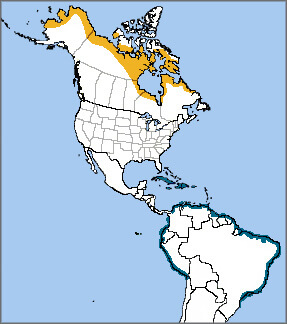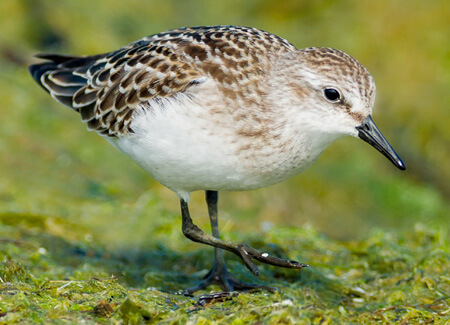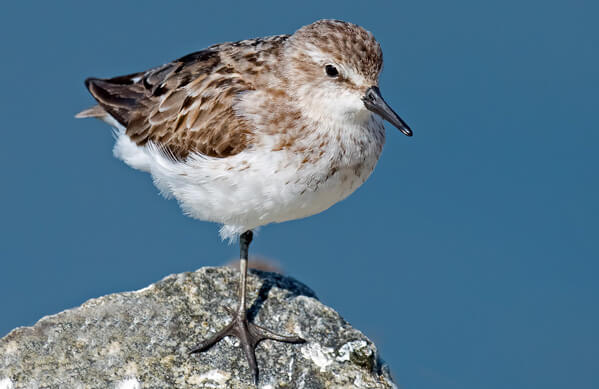 "The restlessness of shorebirds, their kinship with the distance and swift seasons, the wistful signal of their voices down the long coastlines of the world make them, for me, the most affecting of wild creatures. I think of them as birds of the wind, as ‘wind birds.'" — Peter Matthiessen, The Wind Birds
"The restlessness of shorebirds, their kinship with the distance and swift seasons, the wistful signal of their voices down the long coastlines of the world make them, for me, the most affecting of wild creatures. I think of them as birds of the wind, as ‘wind birds.'" — Peter Matthiessen, The Wind Birds
The dainty Semipalmated Sandpiper is named for the partial webbing between its toes; the word “palmate” means webbed. Often hard to see, this adaptation allows the birds to easily walk without sinking over the mud flats where they feed. The Western Sandpiper is the only other small sandpiper with similarly webbed toes.
The birds measure only 5 to 6 inches in length, but these little “wind birds” are long-distance flying champions in spite of their small size. Like other long-distance migrants such as the Blackpoll Warbler, Semipalmated Sandpipers feed heavily in preparation for their journeys, accumulating extensive fat reserves necessary to power their long flights.
Semipalmated Sandpipers, like other small North American sandpipers of the genus Calidris, are often called “peeps” for their short, piping call notes, given as the birds fly and feed.
Epic Journeys
Semipalmated Sandpipers move thousands of miles between their Arctic breeding and South American wintering grounds each year. Their fall migrations are epic, nonstop flights of up to 2,500 miles across the ocean, from New England and southern Canada to South America. Huge flocks of up to 350,000 Semipalmated Sandpipers gather at key stopover sites to feed, including the Delaware Bay and the Bay of Fundy.
No matter the season, these sandpipers always seem to be on the move. They forage in flocks along mudflats at low tide, feeding on small aquatic and marine invertebrates.
Sign up for ABC's eNews to learn how you can help protect birds
Speedy Breeders
On their Arctic breeding grounds, male Semipalmated Sandpipers quickly establish territories using aerial displays and vocalizations. Once a female enters his territory and the birds form a pair bond, the female selects a scrape from several the male has made, then proceeds to nest.
Both male and female incubate the eggs. Like other birds that breed during the brief Arctic summer, including Buff-breasted Sandpiper, nesting proceeds quickly; a pair of Semipalmated Sandpipers can raise up to four young in just a few weeks
Shortly after her chicks hatch, the female Semipalmated Sandpiper deserts the nest to begin her southward migration, leaving the male behind to tend the chicks until they fledge. After their first fall migration, most juvenile birds stay in South America, then make their first northward journey in their second year.

Semipalmated Sandpiper by Paul Reeves Photography, Shutterstock
Running a Gauntlet of Threats
Although still considered abundant, Semipalmated Sandpiper populations have been declining since the 1970s at an estimated rate of five percent per year. This species is classified as Near Threatened on the IUCN Red List.
This species' greatest threat is unregulated hunting. During the birds' southbound migration and on the wintering grounds, hunters and poachers shoot tens of thousands of shorebirds each year.
Overharvesting of horseshoe crabs in Delaware Bay also threatens the species, just as it does Red Knot. Huge numbers of both species pauses there to fatten up on protein-rich crab eggs during their spring migration. Pesticides and climate change, particularly the increasing frequency and severity of hurricanes, are also thought to be exacerbating population losses.
Donate to support ABC's conservation mission!



















































